
Judging by the comments when I posted a picture of my recipe-testing efforts for this column, I seem to be the one of the few people who didn’t grow up with some version of this dessert, which Arabella Boxer describes as “a good hot pudding, quick and simple to make, which has been all but forgotten”. Known variously as lemon surprise, lemon delight and even magic lemon pudding, it’s a winter dessert of the sharp and zesty kind, rather than comfortingly solid type, with a “charming little surprise”, to quote Margaret Costa, in the form of the sauce that appears, as if by magic, in the bottom of the dish after baking. A proper pudding, with the royal seal of approval from Mary Berry, Delia Smith and Nigel Slater, but without the stodge.
The pudding
Most of the recipes I try use some combination of butter and sugar, mixed with egg yolks, milk, lemon and a little flour to make a batter, then leavened with beaten egg whites, but there are a couple of outliers. First, Regula Ysewijn’s castle pudding from her first book Pride and Pudding, which, strictly speaking, isn’t a self-saucing pudding, but a steamed lemon sponge, and so buttery and delicious, that I couldn’t resist giving it a mention for anyone after something a little more rib-sticking at this time of year.
Heston Blumenthal’s flourless example, based on a recipe from the kitchens of St John’s College, University of Cambridge, is a water pudding, which, according to the Foods of England website, is a “simple, flummery-like pudding of egg and lemon frothed in water and baked, known from news items since the early 19th century.” His take, however, includes butter in somewhat larger quantities than older examples, and somehow I end up with a delicately quivering, smooth lemon pudding the texture of a light jelly above a butter sauce. It’s delicious, but not, I suspect, quite as intended.
With the exception of pastry chef Karen DeMasco’s recipe from the New York Times, which leaves out the butter and uses buttermilk instead of milk, the others all differ only in the ratio of eggs, butter, sugar, milk and flour called for. The lightest pudding, in Boxer’s Book of English Food and credited to a Mrs Arthur James (otherwise known as the Edwardian society hostess, racehorse breeder and alleged royal mistress Venetia Cavendish-Bentinck), calls for a mere 15g of butter and two eggs, and the richest, from chef Margot Henderson’s book You’re All Invited, 200g butter and eight eggs. The Australian Women’s Weekly’s lemon delight that features in so many happy childhood memories uses five times as much flour as Costa’s equally beloved version from her Four Seasons Cookery Book, and, unsurprisingly, leads to starchier results.
As is so often the case, the best pudding for you will depend on what you fancy. If you’re cooking for adults and hoping to impress, Henderson’s deliciously tart, ridiculously rich recipe is the one to go for; it’s like eating hot lemon curd straight from the jar, and is particularly good with cold cream on top. If you’re after slightly stodgy comfort food, then the Australian Women’s Weekly’s version will appeal. Conversely, if you want something more delicate, go for James’s or DeMasco’s takes – the latter, with its tangy buttermilk, is as frothy and fun as eating a sherbet lemon. I’ve decided that mine will sit somewhere in the middle – clean and light, but still emphatically a pudding – so I’ve used a relatively modest amount of butter (melted, as per the Australian Women’s Weekly method, which makes it easier to incorporate) and flour, and an average number of eggs.
The flavouring
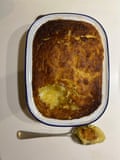
Ysewijn tops her steamed sponges with dollops of lemon curd, as well as adding grated zest to the batter, but classic self-saucing numbers are generally flavoured with lemon juice, but my testers and I miss the bitter notes of the zest in James’s pudding. Though diners should be in no doubt that this is a lemon dessert, I’ve avoided the intensely sweet-and-sour character of a few of the recipes, because I don’t find it particularly comforting. If however, you enjoy being whacked round the chops with winter fruit, then by all means increase the amount of juice and zest.
Equally, you could add a second flavour. Henderson goes for vanilla extract, but ground cardamom, ginger, nutmeg or even black pepper would be happy pairings, and it strikes me you could even infuse the milk with the likes of basil or thyme.
The cooking
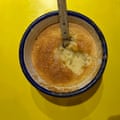
Many recipes call for individual ramekins, but this is a dessert that I think looks more pleasing, not to mention generous, when served from a big bowl, as Henderson recommends. Make sure you grease it well to make serving it easier, and cook it in a tin of water so the base remains loose and custardy even as the top rises and dries out into an airy, almost souffle-like crown – don’t worry about a bit of cracking; that’s to be expected.
Though this pudding is best dug into hot from the oven, it’s surprisingly good cold, too, should you want to work ahead. A jug of cream, though recommended by all my testers, is entirely optional, and you may wish to add fresh berries on the side (raspberries for Mrs Arthur James, blueberries for DeMasco), though, because few are in season, tinned fruit might be preferable. Personally, however, I like it best straight from the dish.
Perfect self-saucing lemon pudding
Prep 15 min
Cook 30 min
Serves 6
25g butter, plus extra for greasing
100g caster sugar
3 eggs, separated
40g flour
1 tsp baking powder
A pinch of salt
260ml milk
Zest and juice of 2 lemons
Melt the butter in a saucepan, then set aside to cool slightly. Meanwhile, grease a medium ovenproof dish (the one I used was 21cm x 15cm) with butter and get out a roasting tin large enough for it to sit in. Heat the oven to 180C (160C fan)/350F/gas 4 and boil a full kettle.
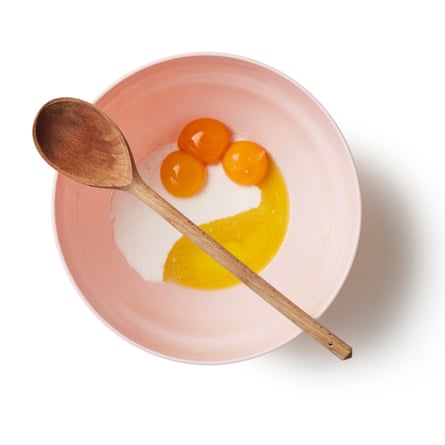
Stir the butter and sugar in a large bowl. Mix the egg yolks into the butter mix, and put the whites into a second large bowl.
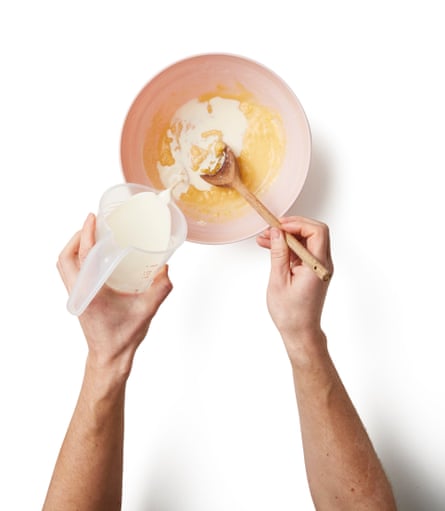
Stir the flour, baking powder and salt into the butter mixture, followed, bit by bit by the milk, and mix to a smooth batter. Finely grate in the lemon zest, then add the juice (you should have about 75ml).
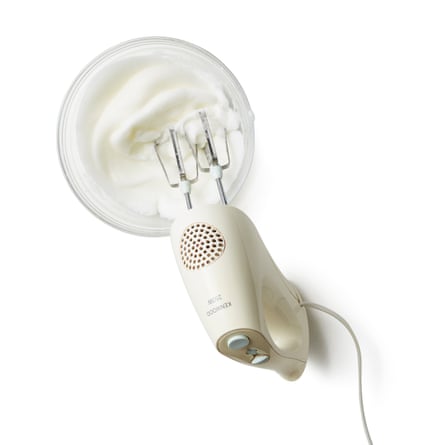
Whisk the egg whites to soft peaks, then fold a spoonful into the batter. Carefully incorporate the rest of the egg whites, so you keep as much air in them as possible.
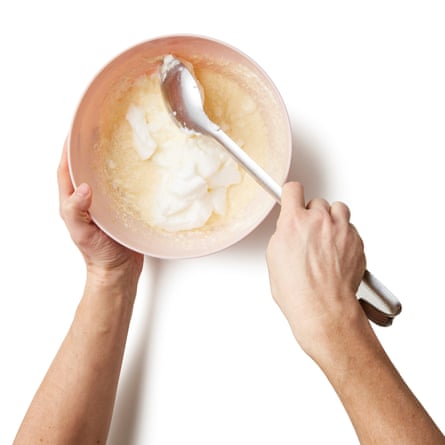
Pour the mix into the buttered dish (it should almost fill it to the brim), then sit the dish in the roasting tin.

Pour in enough just-boiled water to fill the tin by two-thirds, then carefully transfer to the oven and bake for 30 minutes, until the pudding is golden and set fairly firm on top, but still appreciably jiggly below the surface. Serve hot or cold.
-
Lemon pudding, surprise or delight: if you have fond memories of this dish, what did you call it, and who was responsible? And are there other flavours of self-saucing puddings out there?



